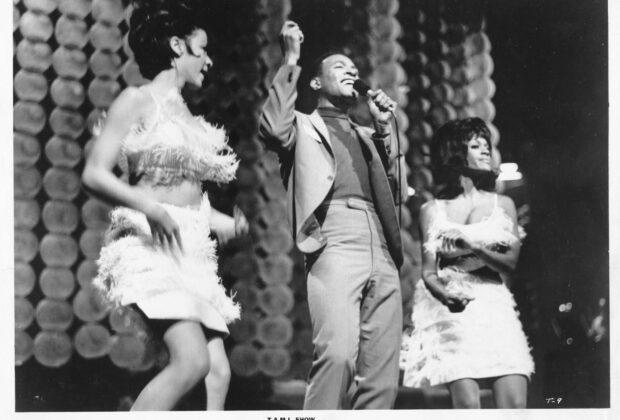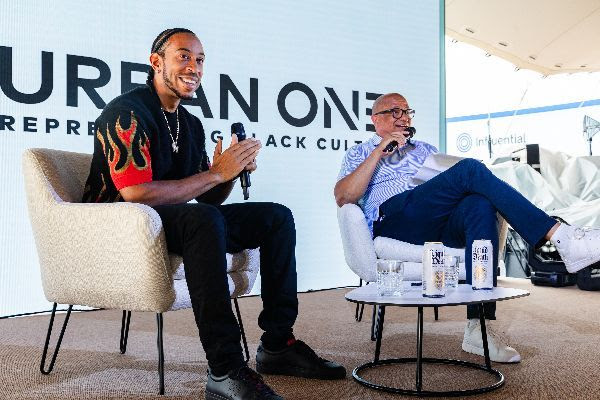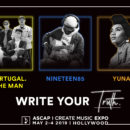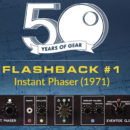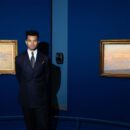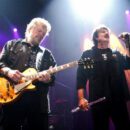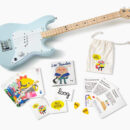Artifacts Courtesy of Gary Pig Gold
"Some people point to JFK's assassination or the Beatles on The Ed Sullivan Show or maybe Dylan going electric as the birth of the mythic sixties, but for me it's the ninth inning of The T.A.M.I. Show all the way. When the Rolling Stones hit the stage, it's like you can feel the whole of American culture pivot in a way that's so dramatic it borders on complete confusion, a pandemonium of the spirit.
"And here's the thing: Everybody that performs beforehand is wonderful, more than wonderful, the most beautiful blend of post-war All-American Black and White musical exuberance.
"In fact, that's part of what makes the Stones' entrance such a jarring, one-two knockout punch--it would have been a top notch variety show without them, a magical time captured...but one half-minute into 'Round and Round' you know you've entered a different space for which a whole new something will be required. Call it erotic, demonic, primordial, orgiastic, anarchic--call it what you want but don't call it show biz because there's no telling what could happen. Well...the sixties happened.
"The T.A.M.I. Show is a before and after deal. The teenagers of America will never know pure innocence again." ----Novelist Daniel Weizmann, author of The Last Songbird.
During late 2024, a documentary re-examining the 60th anniversary of The T.A.M.I Show is scheduled for release.
Fans of classic rock and soul rejoiced when the legendary concert Steve Binder-directed film T.A.M.I. Show made its DVD debut on Shout! Factory in 2009. It subsequently shipped to retail outlets as a Blu-ray, along with its long-lost—and much requested—follow-up, The Big TNT Show, directed by Larry Peerce, on December 2, 2016, as part of the 2-disc Blu-ray set T.A.M.I. Show / The Big T.N.T. Show Collector's Edition, issued from Shout! Factory. The Big T.N.T. Show was also released as a stand-alone DVD on the same day.
The package contains all the bonus features from the T.A.M.I. Show DVD, plus new interviews with The Big T.N.T. Show performers singer Petula Clark, MFQ's Henry Diltz and the Lovin' Spoonful's John Sebastian. The product is mastered from a High-Definition transfer.
One of the most heralded rock events ever captured on film, right up there with producer Jack Good and the Rolling Stones introducing Howlin' Wolf on the 1965 ABC-TV network music series Shindig!, the 1964 concert known as T.A.M.I. Show [Teenage Awards Music International] presented a lineup like no other, the Rolling Stones, James Brown and the Famous Flames, the Barbarians, Billy J. Kramer and the Dakotas, Gerry and the Pacemakers, the Beach Boys, Marvin Gaye, the Miracles, the Supremes, Chuck Berry, and Lesley Gore. The hosts were Jan & Dean.
The production was done over two days and nights on October 29 and 30th '64 on Pico Blvd. at the Santa Monica Civic Auditorium on Pico Blvd. David Winters and Toni Basil served as choreographers. Marshall Berle, Howard Wolf, John Landis and David Cassidy were in the audience.
I was literally across the street one of the afternoons, with my surfer pal Peter Piper at the Con Surf Board shop and buying paraffin wax for our surf boards to even realize what was happening inside that Welton Becket-designed venue.
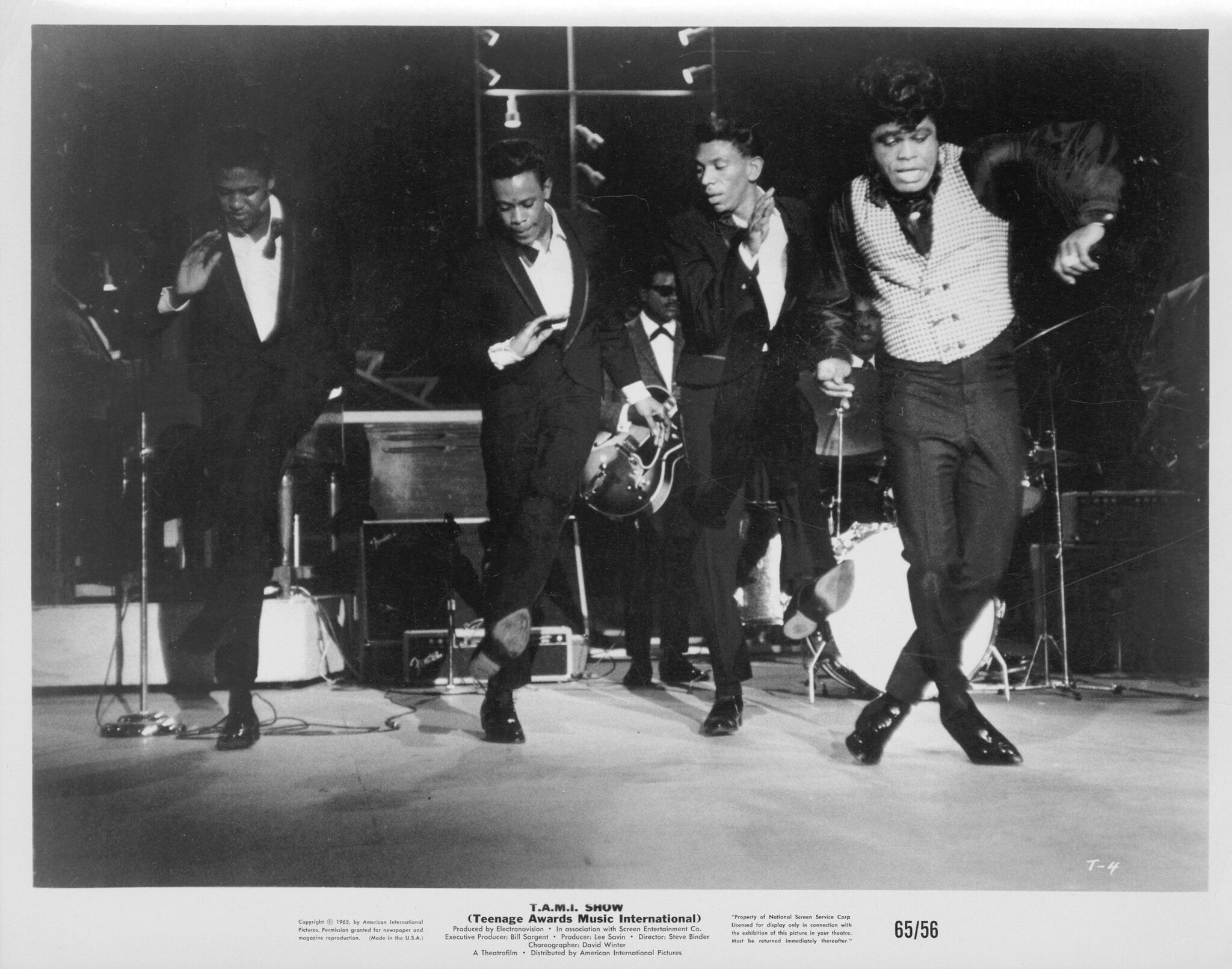
Aside from the five self-contained rock groups, all the other performers were backed by a band assembled by arranger/musical director Jack Nitzsche: Hal Blaine, Jimmy Bond, Lyle Ritz, Don Peake, Tommy Tedesco, Glen Campbell, Barney Kessel, Nino Tempo, and Leon Russell, along with Fanita James, Jean King, and Darlene Love, billed as the Blossoms, provided stage vocals.
Sound engineer Dave Hassinger served as audio consultant, and the Steve Barri/Phil (PF) Sloan songwriting team composed the theme song.
Director Steve Binder, a native of Los Angeles, attended Los Angeles High School, subsequently departed the University of Southern California before graduating to apprentice under host Steve Allen, who pioneered a variety show.
Binder, barely in his twenties, then took on Jazz Scene USA, bringing live performances by musical masters to a network audience.
Steve understood the unique requirements of lighting and blocking for musicians in an optimal setting. Once The T.A.M.I. Show was screened in Britain and the United States theatrically in 1965, the flick informed every subsequent rock concert feature film. [It had a very brief December 1964 exclusive run in Los Angeles area movie houses].
Binder is an Emmy and ACE award-winning producer, director, writer, educator, and Golden Globe nominee. The Los Angeles Times called his first feature film, The T.A.M.I. Show, “the greatest of all rock 'n' roll films.”
He directed the weekly January 12, 1965-April 11, 1966 television music series for NBC-TV, Hullabaloo. Viewed today, it is clear that he understood the unique requirements of lighting and blocking that showcased rock and pop musicians in an optimal setting.
In 1968, Binder conceived, directed, and then co-produced with engineer Bones Howe, ELVIS, The ‘68 Comeback Special. TV Guide called this landmark event “the second greatest musical moment in television history next to the Beatles' debut on The Ed Sullivan Show.”
“When I played Elvis the edited 60-minute version of the show in a projection room at NBC and at the first screening of the show we had a lot of the staff that did the show, the entourage in the room, it was packed,” recollected Binder in a 2008 interview we conducted.
“When it was over Elvis told everybody to get out of the room and he wanted to see it again with just me in the room with him. Elvis said to me in that room, ‘Steve, it’s the greatest thing I’ve ever done in my life. I give you my word I will never sing a song I don’t believe in.’”
"Going back to The Steve Allen Show and Hullabaloo where I was collecting people all the way through my career that I wanted to have in my team and work together with," Binder explained to me in our 2008 interview.
"And in those days, technically, union wise, you unless you had a union card you weren’t supposed to participate. I learned together the difference between making records and television audio. It was a perfect marriage. Even in lighting I would bring in rock ‘n’ roll guys who did concerts with guys bred on television and movies. All of a sudden, they were learning about the contemporary music business.”
"I met the Stones in 1964," remembered Jack Nitzsche in a 1988 interview I published in Goldmine magazine.
"Andrew Loog Oldham [the manager of the Rolling Stones] called me up. He and the group had met Phil Spector and Andrew and the Stones wanted to meet me. Brian Jones was in a three piece suit and tie. It was at RCA studios and I was working with Edna Wright, Darlene Love’s sister. A little later, Andrew and the Stones started working at RCA.
"I got them into The T.A.M.I. Show. I put the band together and did all the arrangements. I was the musical director. I had told the producer, Bill Sargent, the Stones were going to be big. I felt the Stones could close the show," underlined Jack.
“Bill said ‘James Brown is going to close the show.’ We all stood at the side of the stage watching James Brown do his act. People were standing and screaming for James. (Legend has it that James told the Stones, ‘you’ll never be able to follow this.’). Then the Stones came out and all the girls started crying. It was a whole new emotion!
"After the filming, the Motown acts all asked for copies of my charts that I used for the house band," Jack smiled.
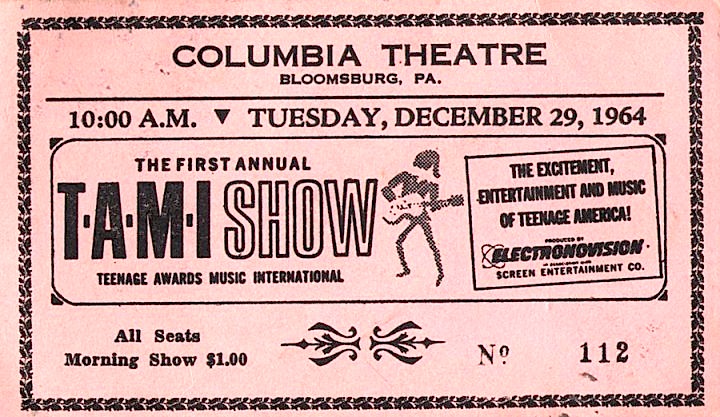
Dave Hassinger who engineered the Andrew Loog Oldham-produced 1964-1967 albums with the Stones at the RCA studios in Hollywood was the audio consultant for The T.A.M.I. Show.
Guitarist Don Peake, unlike many of his American contemporaries on the Santa Monica Civic Auditorium stage, already knew the Rolling Stones from a UK 1963 September 29-November 3rd Don Arden-produced tour he did with the Everly Brothers. Also on the bill were Bo Diddley, Julie Grant, Mickie Most, and the Flintstones.
Don had sat with Keith Richards on many occasions, coaching and showing him instrument tips at various stops on the trek.
"I have picked up as many hints on guitar playing as I can from Don Peake, who is the Everly Brothers guitarist," volunteered Keith Richards in a 1963 edition of New Musical Express. "He really is a fantastic guitarist, and the great thing about him is that he is always ready to show me a few tricks."
“I really loved touring with the English groups, back in 1963 and 1964. We used to tour with the Rolling Stones and people like Georgie Fame," Bobby Rogers of the Miracles emphasized in a 1974 interview I did with him for Melody Maker.
" During the breaks from touring, a lot of the groups would ask questions about certain songs on our albums. I remember when we filmed The T.A.M.I. Show Mick Jagger asked me about what I'd thought of the album James Brown Live At The Apollo, which was his favorite LP.
“One time on a tour he mentioned that he'd like to record a Marvin Gaye song for the next Stones album. A month later, 'Hitch Hike' was being played all over Detroit radio.
"Man, those early tours were a trip. Endless hours of bus rides and all these skinny English dudes asking us about the Tamla Motown sound. I never realized how important or influential we were on groups like the Beatles and Stones. We used to party with all the groups, and have become good friends. You know, music travels in sort of a cycle. The early days were beautiful. We dug all the people we played with. Back in 1965 my favorite song was 'Get Off My Cloud.’”
In a 2010 dialogue with Mary Wilson, a founding member of the Supremes, she recalled The T.A.M.I. Show booking.
"We were happy for it. And as a group, it took us into areas we wanted to go, which is great. I loved to tour. I went to the Whisky a Go Go in the sixties. I always went out to see everybody, loved seeing other acts. I’ve toured with Bill Wyman in England. And he and I always talk about The T.A.M.I. Show. We all thought James Brown was gonna close the show. And all of a sudden, we heard this rumor back stage that the Rolling Stones were closing. Bill said they were all scared. And they became great friends, which was really cool."
In 2004 I interviewed author, lecturer, and record producer Andrew Loog Oldham. I asked him about The T.A.M.I. Show in my 2006 book Hollywood Shack Job Rock Music In Film and On Your Screen.
"Why it works for me is the fear and loathing in Santa Monica There you go. Come on man, it’s a magic moment.
“Every other British act got 25 grand each, there and we thought had some Stones’ muscle, but it was a package deal with General Artists Corp.
"Seeing the Motown acts was terrific. Seeing Jack Nitzsche and Dave Hassinger. It was the film within the film. ‘Isn’t it nice to be in this business? Everyone is working together for one thing. The Beach Boys’ shirts were horrendous. Isn’t it nice we’re all here?' The Stones were becoming successful, and getting good, and wait a minute, we gotta follow James Brown?
“Bill Sargent did The T.A.M.I Show andthe black and white Electronovision Harlow with actress Carol Linley.”
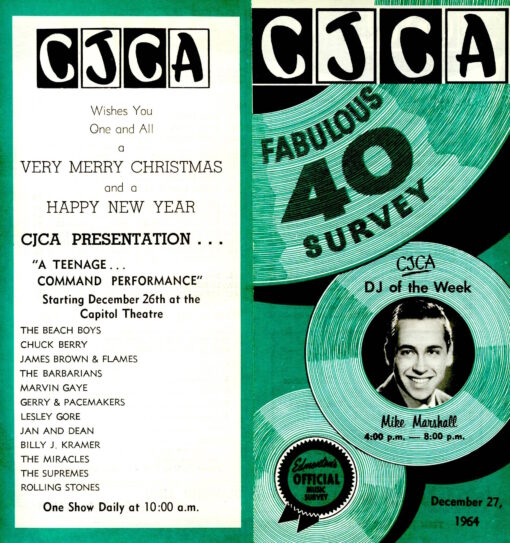
Electronovision Productions released the movie through Screen Entertainment Company with distribution in the United States via American International Pictures.
In the early sixties, engineer Sargent with Joseph E. Bluth developed an electronic camera system with better resolution than traditional television cameras known as Electronovision technology.
Bluth served as technical director on the Los Angeles television station KTTV 1950-1951 TV series, The Buster Keaton Show.
Electronovision was a cinematic game-changer, a pioneering big screen moment, where video was converted to film, and transferred by kinescope recording, which enhanced resolution that informed big screen enlargement.
In a 2001 interview I had with Bill Wyman, I asked him about The T.A.M.I. Show and the stage presence of the Rolling Stones.
“The band was great live always. Always. The Stones were a better live band than any other band at that time. I’m not saying they were the greatest songwriters or the greatest recording artists, but they were the best live band wherever you went. You could go up on stage and blow everybody away no matter who they were.
“As long as me and Charlie could get it together, then the rest of the band could do what they’d like and it worked. And that’s what happened in the studio, and that’s what happened live. Me and Charlie were really always on the ball, always straight, always together and had it down.”
In 2001, I spoke with dancer Toni Basil, who helped choreograph The T.A.M.I. Show with David Winters.
“I said to myself ‘How can anybody follow James Brown?’
“Anyway, Jack [Nitzsche] pointed this out to me, and I later heard as well, that Andrew Loog Oldham was so smart that he staged a massive equipment breakdown as well as suggesting some camera angles. I just knew that Andrew was saying that the Stones’ equipment broke down and they had to wait for stage set up. We knew it was some time would pass after James Brown’s performance.
“So, finally, maybe the tune was ‘It’s All Over Now,’ where there is a big cymbal crash in the opening of the song and Mick had a tambourine in his hand and I wanna tell you simultaneously with that crash in the music Mick jumped up in the air, and as he jumped up in the air, Brian Jones turned his back to the audience, which was the first rebellious piece of theater I had ever seen in my entire life," marveled Basil.
“I come from vaudeville. My parents were in vaudeville, on stage shows. You never turned your back to the audience. So, Mick was jumping in the air, Brian had his back to the audience, and Mick hit the ground in a crouch. Not one person ever remembered James Brown again. And neither did I.
“Mick’s moves were fantastic. What is this? What is he doing, ya know? As a trained dancer and even as a Go Go dancer and a street dancer, I had never seen such moves in my life. I mean, what they really were post-modern and right on the beat.
“It doesn’t matter what physically you’re doing as long as you’re grabbing the beat. But Mick was doing physical moves that no one had ever seen before. In the same way James Brown was doing physical moves that no one had ever seen before. And Brian [Jones] had his back to the audience for a lot of the set. He was a rebellious comet and hardly turned around which made it extremely powerful. It helped this rebellious theater. I really did.
“If Brian would have faced front, it would be great, and Mick would have been great but there was a theatrical ambience that Brian brought because he turned his back. And the Stones didn’t take a bow, which I thought was shocking. I mean, even James Brown came on and took a bow.
“Elvis Presley, James Brown and Mick Jagger had some similarities regarding dance. They moved exactly to the beat. They understood the back beat. And James of course, understood it from a Gospel sense. But Mick, even though his moves were very abstract, and they were almost like where white boys do that can’t dance to the beat, but the difference with Mick is, he did dance to the beat.
“What Elvis, James and Mick had in common was that they were nailing the beat. They were all physically dancing to the beat. They weren’t like guys who came before them like Frank Sinatra, or those people who would move to the lyric. Their movements came about from the story. Their movements didn’t come about the story. Their movements came because of the music.
“One more thing about The T.A.M.I. Show," added Toni. "When Smokey Robinson and the Miracles earlier did ‘Mickey’s Monkey,’ I lost my mind. That was really something. And Jack Nitzsche was brilliant. He was the one who called the shots of what order people went in. And man, he didn’t make a mistake. How did he know he could put the Stones on after James Brown? To this day I didn’t know how he had the balls to do that and how he had an idea that it could be pulled off like it was.”
“In a stunningly monochromatic case of Life imitating Art imitating Pop and Soul, The T.A.M. I. Show is the living, beating, in-the-flesh reincarnation of all those cavalcades of stars Alan Freed would assemble during the closing reels of most each and every Fifties B-flick beginning with the word ‘Rock,” is how music journalist Gary Pig Gold described the legendary sight and sound collaboration in 2005.
“Indeed, in TAMI we can still see Gerry Marsden in a guitar duet to the death with none other than Chuck Berry, Mick Jagger wisely conceding to take on the blue-flaming Butane James Brown, the Barbarians’ five-fingered drummist practically inventing Garage Rock, Marvin Gaye hitch-hiking after Diana Ross’ supreme eyeful, and to top it all – to HOST it all, no less – those Clown Princes of Surf ‘n’ Roll themselves, Jan and Dean!
“Steve Binder recorded absolute history with this screaming little film; even the briefest glance towards Dennis Wilson’s moptop during ‘Surfin’ USA’ will tell you why.”
Harvey Kubernik is the author of 20 books, including 2009’s Canyon Of Dreams: The Magic And The Music Of Laurel Canyon and 2014’s Turn Up The Radio! Rock, Pop and Roll In Los Angeles 1956-1972. Sterling/Barnes and Noble in 2018 published Harvey and Kenneth Kubernik’s The Story Of The Band: From Big Pink To The Last Waltz. In2021 they wrote Jimi Hendrix: Voodoo Child for Sterling/Barnes and Noble. Otherworld Cottage Industries in 2020 published Harvey’s Docs That Rock, Music That Matters.
Kubernik’s writings are in the book anthologies The Rolling Stone Book Of The Beats and Drinking With Bukowski. Harvey wrote the liner notes to the CD re-releases of Carole King’s Tapestry, The Essential Carole King, Allen Ginsberg’s Kaddish, Elvis Presley The ’68 Comeback Special, The Ramones’ End of the Century and Big Brother & the Holding Company Captured Live at The Monterey International Pop Festival.
During 2006 Harvey spoke at the special hearings initiated by The Library of Congress held in Hollywood, California, discussing archiving practices and audiotape preservation. In 2017 Harvey Kubernik appeared at the Rock and Roll Hall of Fame in Cleveland, Ohio, as part of their Distinguished Speakers Series.
During 2022, producer/director Ron Chapman interviewed Harvey and hired him as a consultant for his music documentary, REVIVAL69: The Concert That Rocked the World, which celebrates and chronicles a 1969 rock festival in Toronto, Canada that spotlighted the debut of John Lennon's Plastic Ono Band along with the Doors. Kubernik in 2019 was a Consultant on a 2-part documentary Laurel Canyon: A Place In Time on the musical legacy of Laurel Canyon. Allison Ellwood directed the film which debuted on EPIX.
Kubernik served as Consulting Producer on the 2010 singer-songwriter documentary, Troubadours: Carole King/James Taylor & the Rise of the Singer-Songwriter, directed by Morgan Neville. In 2019, Harvey was a feature on-screen interview for director Matt O’Casey on his BBC4-TV digital arts channel Christine McVie, Fleetwood Mac’s Songbird. The cast includes Christine McVie, Stan Webb of Chicken Shack, Mick Fleetwood, Stevie Nicks, John McVie, Christine’s family members, Heart’s Nancy Wilson, Mike Campbell, Neil Finn, and producer Richard Dashut.
Kubernik was a featured talking head in director Matthew O’Casey’s 2012 Queen at 40 documentary broadcast on BBC Television and released as a DVD Queen: Days Of Our Lives in 2014 via Eagle Rock Entertainment. Harvey was also taped for the 2013 BBC-TV documentary on Bobby Womack Across 110th Street, directed by James Meycock. Womack, Ronnie Wood of the Rolling Stones, Damon Albarn of Blur and the Gorillaz as well as actor Antonio Vargas are featured. In May 2014, filmmaker O’Casey lensed Kubernik in his BBC-TV documentary on singer Meat Loaf, titled Meat Loaf; In and Out of Hell, broadcast in the U.S. market in 2016 on the Showtime Cable TV channel.

